This post contains affiliate links. We earn commissions if you purchase products from retailers after clicking on a link from our site. As an Amazon Associate, we earn from qualifying purchases.
If you’re a percussionist trying your hand (get it?) at the bongos, you might find that it’s a very different than playing with sticks. There are specific skills to focus on that I’ll cover in this post
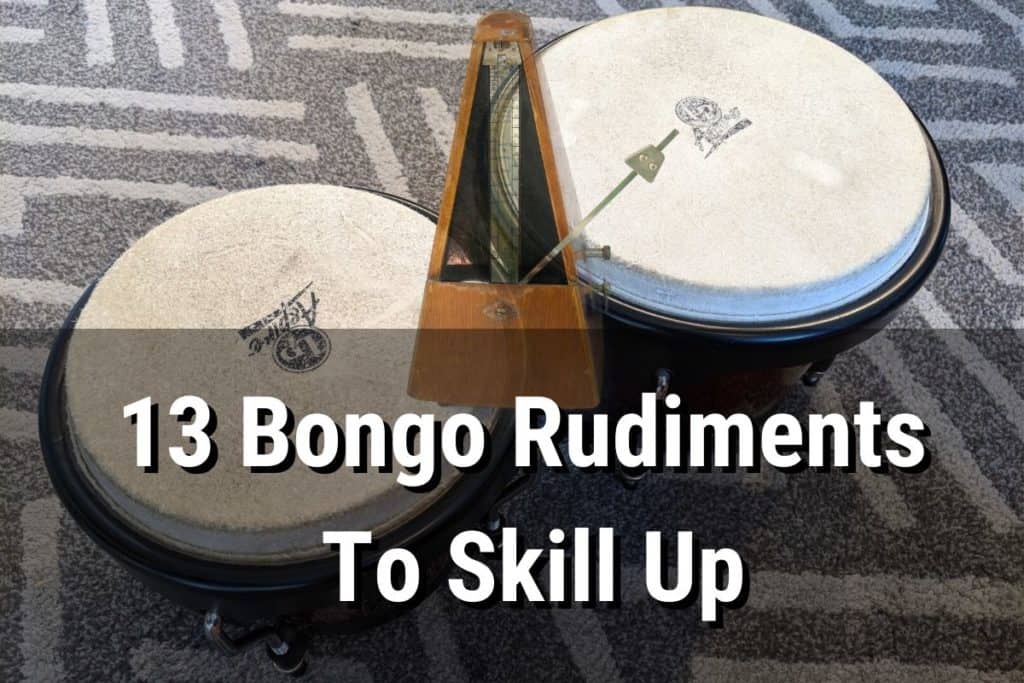
By the way, looking for recording equipment and musical instruments? Check out Sweetwater.com for microphones, monitors, audio interface or any other recording gear that you could ever need. (Affiliate Link)
If you want to level-up your skill at playing the bongos, I’ve created 13 rudiments for the bongos and I’ll explain what skills these rudiments will help with.
Make sure to bring out your metronome!
If you practice these drills without a metronome– I hate to be the bearer of tough love, but it will almost be as good as not practicing at all. As a percussionist, it’s a sacred duty to keep the rhythm of the song–the band relies on the percussionists to keep time and make sure the song is locked and solid.
Focus on evenness and consistency, not speed.
Single-Stroke Roll
Bounce rolls are not really a thing when playing bongos, and Double-stroke rolls are less common (although they can still be helpful), however, single stroke rolls are fundamental to bongo playing and you can’t live without them.
These exercises should be started very slowly (40-60 bpm). Being able to play single stroke rolls evenly makes a huge difference in the quality of your single stroke rolls.
As far as what parts of your hands to use while practicing, there’s nothing wrong with trying everything that you’d normally play. Try practicing with just your index fingers, or try playing with the first few fingers of both hands.
I’ve also notated these to start with your right or your left hand. If you’re like me, starting on the left is surprisingly hard and it takes some effort to get the rhythm to match up with the right.
Rudiment 1: Single Stroke Roll
Naturally, the first exercise is a simple single stroke roll:

These are 32nd notes, so give these all the time you can.
Rudiment 2: Single Stroke Roll On Offbeat
This is worth practicing on its own since many rhythms you may start your single-stroke roll on the offbeat (or anywhere really). It’s a different flow and feel so start slow and work upwards when you can.
Make sure you don’t skip starting on your left hand.
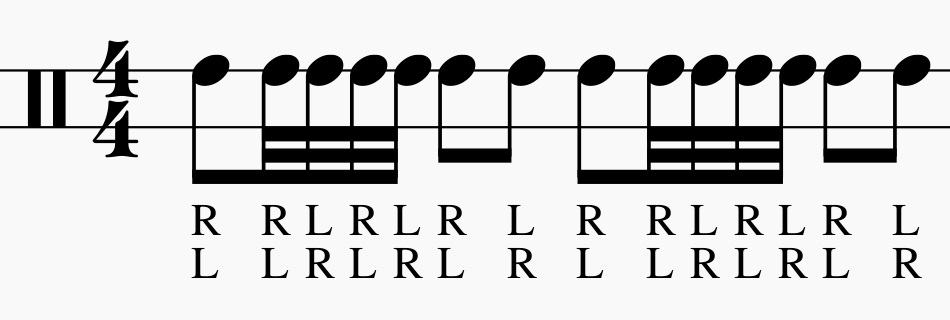
Rudiment 3: Single Stroke Roll With Accents
This exercise will help you nail down the evenness between your left and right hands if you practice starting on each hand.

Clave Exercises
The clave is fundamental to Latin music, and therefore to the bongos. Even if you’re not playing Latin music, the clave is an integral rhythm to many music styles.
Why practice clave exercises?
If you have a set of rhythms that you are playing from that accentuate the clave, you will probably be fine–however bongoseros often have to create rhythms to fill the music they’re playing on the fly, and thus in order to create solos and rhythms that fit inside a song requires a solid understand and feel for the clave.
The word clave means key, and it turns out there are a couple variations of the clave. For the purposes of this post, I’m only going to be sharing exercises for the Son Clave and the Rumba Clave.
Rudiment 4: Son Clave

This rhythm is a little bit tricky to get used to if you are new to it. It’s a great rhythm to practice all by itself. One easy way to get a better feel for the clave is to play it along with music you like. The clave is fundamental in many Latin music genres (and lots of pop too), so it will fit better in some songs more than others.
Rudiment 5: Son Clave 16th Note Drill

Although this is just 16th notes, the accents go along with the son clave, which makes this rhythm tricky but valuable. When you’re playing complex rhythms the danger is losing the clave. Exercises like this one help ingrain the clave into your playing.
Rudiment 6: Son Clave Polyrhythm

Okay, I admit, this rhythm looks scary but trust me it’s actually easier than the previous exercise once you get the hang of it. I recommend breaking this exercise up into one measure at a time, since they are simply mirrors of one another.
The left hand starts out playing the son clave, while the right hand is playing on the beat, then, in the 2nd measure, the left hand plays on the beat while the right hand plays the son clave.
For me this helps solidify where the clave is in a 4/4 song and is actually a bit easier for me to play than the 16th note drill above once my hands figure out how the rhythm works.
Rudiment 7: Rumba Clave

The rumba clave rhythm sure looks more complicated than it is. It’s almost identical to the son clave except the 3rd note is a 16th note later. Otherwise, everything is the same. This small difference can be tricky to get used to so it’s good to practice.
Rudiment 8: Rumba Clave 16th Note Drill
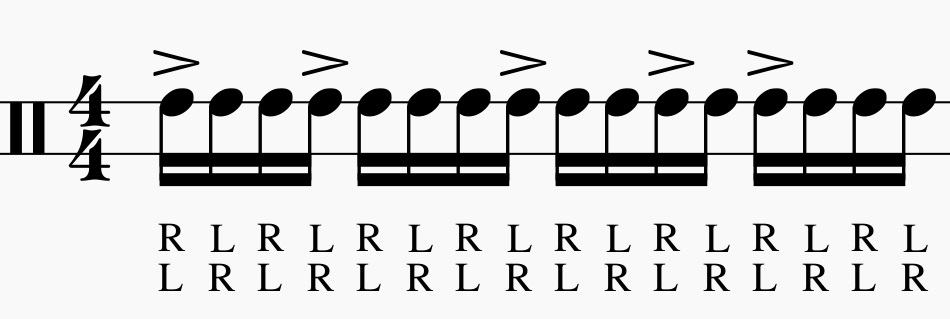
Similar to the son clave exercise above, this drill helps cement the placement of the rumba clave.
Rudiment 9: Rumba Clave Polyrhythm

The right hand is playing quarter notes (keeping the beat) in the first measure while the left hand plays the rumba clave. In the 2nd measure the roles switch with the left hand playing quarter notes and the right hand playing the rumba clave.
Paradiddles
The bongo drums have some skills that can crossover from snare work, one being the paradiddle. The paradiddle is considered a fundamental rudiment for snare players, and it is also important for bongos because many rhythms will require quick transitions from single strokes to double strokes.
Rudiment 10: The Basic Paradiddle
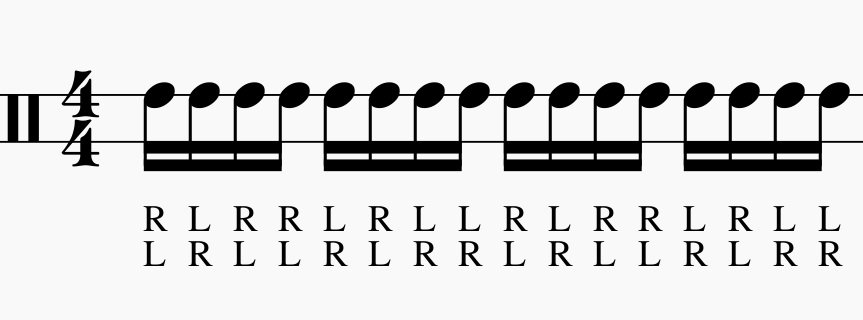
Simple and straightforward: work on making your strokes even so that your right hand is not louder or softer than your left. You can accent every beat as you would if practicing the snare as well, but we’ll mix this up in the next few drills.
Rudiment 11: Paradiddle Son Clave
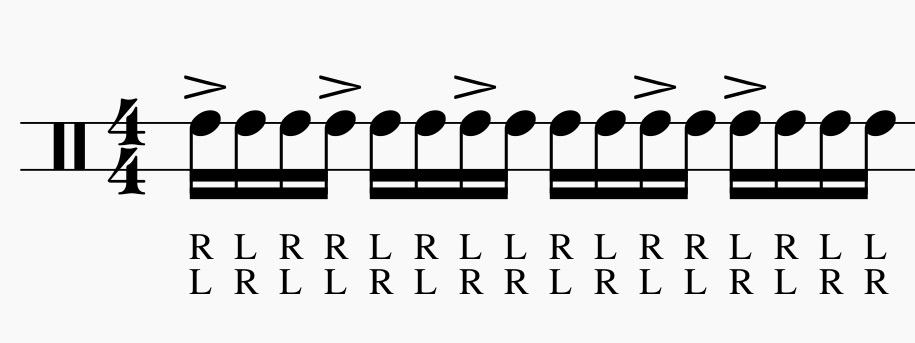
This is a difficult rhythm, but it again will drill in that son clave as well as help you gain more flexibility in your accents, which is important for bongo playing since you are typically playing syncopated rhythms.
Rudiment 12: Paradiddle Rumba Clave
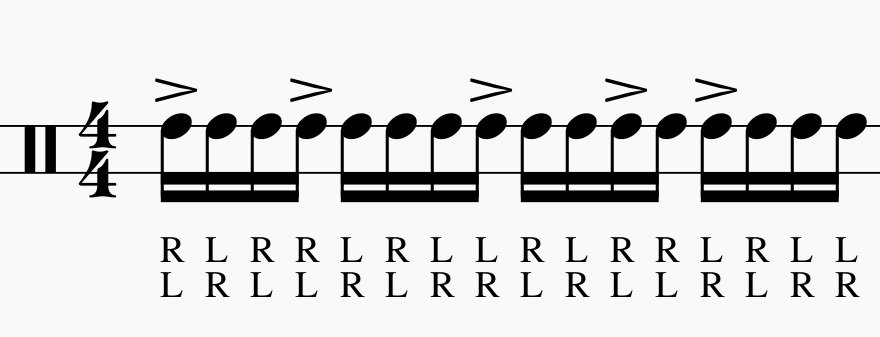
Here is the paradiddle with the rumba clave. Playing these back to back you’ll see how close the two claves really are.
Rudiment 13: Paradiddle Crossover Drill

Very often you are jumping from one bongo to the next–you’ll often see soloists go rapidly from the macho to the hembra and back to the macho. This tricky rhythm will help develop this skill.
I’ve even noticed in some bongo rhythms that you’re required to transition between drums really fast, and it helps to build up these chops even if you aren’t planning on soloing.
What’s Next? What Else to Practice for the Bongos?
These drills will help improve your chops and speed as well as your percussive skill that will help you play more evenly. Keeping time is incredibly important, and the ability to play complicated rhythms makes playing really fun. But where do you go from here?
Many of these drills transfer over to other percussion instruments, but there still are techniques that are specific to bongo playing. These techniques are critical to learning the Martillo and expanding your Latin music capabilities.
Bongo Techniques
If you’d like to see a visual guide to playing bongo techniques, check out our comprehensive getting started guide for bongos here.
Alternatively, if you’d rather learn from a video, you can check out my short video explaining several bongo techniques here:
Bongo Rhythms For Songs
If you’re looking to put these drills to good use, I created a huge list of bongo rhythms (40 in total) that encompasses several music styles including Latin and Rock music. It’s all free–go check it out here.
